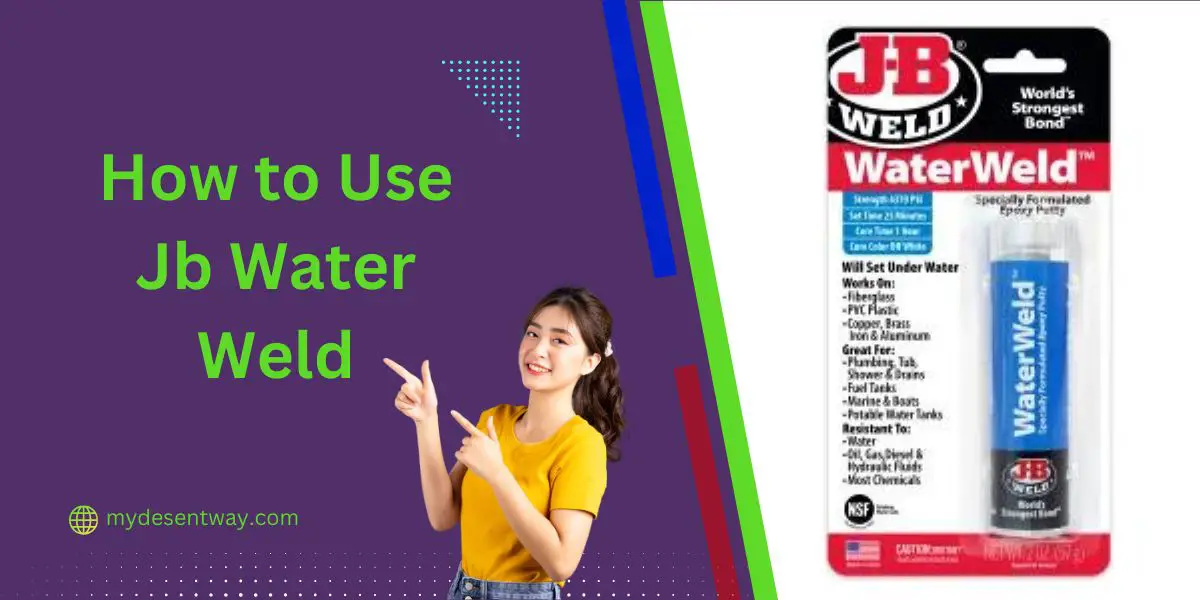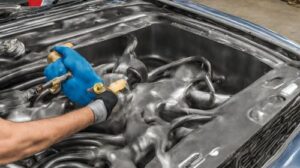Table of Contents
In the world of DIY repairs and quick fixes, having a reliable adhesive is a game-changer. JB Water Weld, a versatile epoxy putty, has gained popularity for its ability to bond and repair a variety of materials. Whether you’re dealing with a leaky pipe, a broken automotive part, or a metal surface in need of sealing, JB Water Weld claims to be the solution. In this article, we’ll explore how to use JB Water Weld effectively.
Understanding the basics is crucial before embarking on any repair project. JB Water Weld is not your typical adhesive; it’s a specially formulated epoxy putty designed for underwater applications. Yes, you read that right – it works even when submerged. The key to success lies in using it correctly.
1. What is JB Water Weld?
JB Water Weld is a two-part epoxy putty that, when mixed, forms a durable bond. It is water-resistant and can be applied to wet surfaces, making it a go-to choice for various repairs, especially in plumbing emergencies.
Composition and Properties
The epoxy putty comprises a resin and a hardener. Once these components are combined, a chemical reaction occurs, transforming the mixture into a solid substance. The cured epoxy boasts impressive strength, adhesion, and resistance to water, chemicals, and temperature variations.
2. Step-by-Step Guide to Using JB Water Weld
Now that we have a grasp of the basics, let’s walk through the process of using JB Water Weld step by step.
1. Preparation of Surfaces
Before applying JB Water Weld, ensure that the surfaces are clean and free of grease or debris. Use sandpaper or a wire brush for better adhesion.
2. Mixing the Epoxy
Take equal parts of the resin and hardener and knead them together until a uniform color is achieved. This step activates the epoxy.
3. Application Process
Apply the mixed epoxy putty to the damaged area, molding it to the desired shape. Smooth the surface with a wet finger or tool.
4. Curing Time
Allow sufficient time for the epoxy to cure. The specific duration varies, so refer to the product instructions. Avoid disturbing the repaired area during this period.
3. Common Applications
JB Water Weld’s versatility extends to a multitude of applications.
1. Fixing Leaks in Plumbing
Seal leaks in pipes or joints, even underwater, with JB Water Weld. It provides a quick and reliable solution for emergency plumbing repairs.
2. Repairing Automotive Parts
From fixing cracks in engine components to patching exhaust systems, JB Water Weld is a go-to product for automotive enthusiasts.
3. Sealing Metal Surfaces
Create a durable seal on metal surfaces, preventing corrosion and ensuring a long-lasting bond.
4. Tips and Tricks
Achieving the best results with JB Water Weld requires some finesse.
1. Maximizing Adhesion
Ensure the surfaces are thoroughly roughened for better adhesion. Cleaning with acetone before application can also enhance bonding.
2. Handling Tricky Situations
For hard-to-reach areas, consider using gloves and tools to mold the epoxy into the desired shape. Precision is key.
3. Storage and Shelf Life
Properly seal unused portions of JB Water Weld to extend its shelf life. Store it in a cool, dry place away from direct sunlight.
5. Safety Precautions
While JB Water Weld is user-friendly, safety is paramount.
1. Importance of Following Safety Guidelines
Adhere to safety recommendations provided by the manufacturer to protect yourself from potential skin irritation or inhalation risks.
2. Protective Gear Recommendations
Wear gloves and, if necessary, a mask to minimize direct contact with the epoxy components.
6. Comparisons with Other Products
Comparing JB Water Weld with traditional adhesives provides valuable insights into its unique advantages. This section explores the distinctions between JB Water Weld and conventional glues, highlighting scenarios where the epoxy putty excels.
JB Water Weld vs. Traditional Adhesives
1. Underwater Application
- JB Water Weld: Excels in underwater applications, making it ideal for plumbing repairs, even while pipes are still leaking.
- Traditional Adhesives: Many conventional adhesives lose effectiveness when exposed to water, making them unsuitable for underwater repairs.
2. Strength and Durability
- JB Water Weld: Offers exceptional strength and durability, creating a robust bond that withstands various environmental challenges.
- Traditional Adhesives: While some traditional adhesives are strong, they may not match the durability of JB Water Weld, particularly in demanding conditions.
3. Versatility
- JB Water Weld: Versatile in applications, suitable for plumbing, automotive repairs, metal sealing, and more.
- Traditional Adhesives: Some traditional adhesives may be specialized for certain materials or conditions, limiting their versatility.
4. Resistance to Chemicals
- JB Water Weld: Resistant to various chemicals, ensuring stability in different environments.
- Traditional Adhesives: Chemical resistance can vary, and some traditional adhesives may degrade when exposed to certain chemicals.
Pros and Cons
Pros of JB Water Weld
- Versatility: Suitable for a wide range of applications.
- Underwater Performance: Excels in underwater repairs.
- Strength and Durability: Provides a robust and durable bond.
- Chemical Resistance: Resists damage from various chemicals.
Cons of JB Water Weld
- Curing Time: Requires adequate curing time for optimal results.
- Storage Sensitivity: Proper storage is essential to maintain effectiveness.
7. Real-Life Success Stories
User Testimonials
Let’s hear from those who have experienced JB Water Weld’s magic firsthand.
I had a leaking pipe in my kitchen, and JB Water Weld saved the day! Easy to use, and the repair has held up perfectly.”
8. Troubleshooting Guide
While JB Water Weld is a reliable solution for many repairs, challenges may arise during application. This troubleshooting guide addresses common issues users may encounter and provides solutions to ensure a successful outcome.
Addressing Common Issues
1. Curing Problems
- Issue: The epoxy is not curing as expected.
- Solution: Ensure that you have mixed equal parts of the resin and hardener thoroughly. Incomplete mixing can result in curing issues. Also, verify that the application area is within the recommended temperature range for curing.
2. Adhesion Problems
- Issue: The epoxy is not adhering well to the surface.
- Solution: Double-check the surface preparation. It’s essential to clean and roughen surfaces adequately before applying JB Water Weld. If the surface is contaminated or too smooth, the epoxy may struggle to adhere.
3. Shape Retention Issues
- Issue: The epoxy is not maintaining the desired shape.
- Solution: If working with intricate shapes or vertical surfaces, consider using tools to mold and support the epoxy. Applying the putty in layers can also help maintain the desired form.
Seeking Professional Help
1. Complex Repairs
- Scenario: The repair is more complex than expected, or the damage is extensive.
- Solution: For intricate or large-scale repairs, especially in critical areas like plumbing or automotive systems, consider seeking professional help. A trained technician can assess the situation and provide expert guidance.
2. Uncertain Application
- Scenario: Uncertainty about the suitability of JB Water Weld for a specific application.
- Solution: If you’re unsure about whether JB Water Weld is the right choice for your repair, consult the manufacturer’s guidelines or reach out to their customer support for assistance. They can provide tailored advice based on your specific situation.
9. Environmental Impact
Eco-Friendly Aspects of JB Water Weld
Considering the environmental impact of products is crucial. JB Water Weld is known for being environmentally friendly, with minimal harm during application and disposal.
Proper Disposal Methods
Follow local guidelines for the disposal of cured epoxy and leftover materials to minimize environmental impact.
10. Future Innovations
As technology advances, so does the potential for innovations in epoxy products like JB Water Weld. In this section, we’ll explore the future landscape of epoxy technology and discuss potential advancements that may shape the industry.
1. Nano and Microtechnology Integration
- Enhanced Adhesion: Future epoxy formulations may incorporate nano or microtechnologies to enhance adhesion properties. This could result in even stronger and more resilient bonds.
- Precision Repairs: Nano and microtechnology could allow for more precise application of epoxy, making it ideal for intricate repairs in electronics or delicate machinery.
2. Biodegradable Epoxy Options
- Environmentally Conscious Formulations: With a growing emphasis on eco-friendly products, the future may see the development of biodegradable epoxy options. These formulations would break down over time, minimizing long-term environmental impact.
- Sustainable Materials: Incorporating sustainable materials in epoxy formulations could become a key focus, aligning with global efforts to reduce the ecological footprint of various industries.
3. Smart Epoxy with Monitoring Capabilities
- Real-Time Monitoring: Future epoxy products might feature smart capabilities, allowing users to monitor the status of repairs in real-time. This could be particularly valuable in critical applications such as aerospace or industrial settings.
- Sensor Integration: Integration of sensors within the epoxy could provide data on factors like temperature, pressure, or structural integrity, offering insights into the condition of the repaired item.
Market Trends and Predictions
1. Increased Demand for DIY Repair Solutions
- Home Improvement Boom: The trend of DIY home improvement projects is expected to continue, driving demand for user-friendly and effective repair products like JB Water Weld.
- Online Tutorials and Guides: The availability of online tutorials and guides contributes to the growing DIY culture, with individuals seeking reliable and versatile repair solutions.
2. Advancements in Automotive Repairs
- Rise of DIY Automotive Enthusiasts: As more automotive enthusiasts engage in DIY projects, there is likely to be an increased demand for advanced epoxy products tailored for automotive repairs.
- Specialized Formulations: Epoxy formulations may evolve to address specific automotive needs, such as high-temperature resistance or compatibility with various materials.
Potential Advancements in Epoxy Technology
What does the future hold for epoxy products like JB Water Weld? Stay tuned for potential innovations and improvements.
video by J-B Weld
Conclusion
In conclusion, JB Water Weld stands out as a reliable and versatile epoxy putty for a wide range of repairs. By following the simple steps outlined in this guide, you can harness its power to fix leaks, mend automotive parts, and seal metal surfaces. Remember to prioritize safety, follow instructions diligently, and explore the possibilities of this remarkable product.
FAQs
Common Queries About How to Use Jb Water Weld
How long does JB Water Weld take to cure?
The curing time varies, but it typically ranges from 20 minutes to a few hours.
Can JB Water Weld be sanded after it cures?
Yes, once cured, JB Water Weld can be sanded for a smoother finish.
Is JB Water Weld suitable for outdoor applications?
Absolutely! JB Water Weld is resistant to outdoor elements, providing a reliable solution for various outdoor repairs.
Can it be painted over?
Yes, JB Water Weld can be painted over once it’s fully cured.
Is JB Water Weld safe for potable water systems?
Yes, JB Water Weld is safe for use in potable water systems. It is certified for contact with drinking water.

